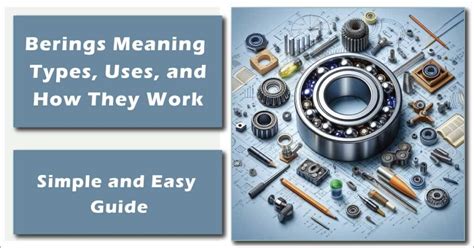A Comprehensive Guide to Bearings: Definition, Types, Applications, and Maintenance
What is a Bearing?
In the realm of mechanics, a bearing is an indispensable component that supports and reduces friction between rotating or sliding surfaces. Its primary function is to transmit loads while enabling smooth and efficient movement. Bearings are ubiquitous in various applications, ranging from everyday machinery to complex industrial systems.
Types of Bearings
There are numerous types of bearings, each designed to suit specific operating conditions and load requirements. Some of the most common types include:
-
Ball Bearings: Utilize rolling elements in the form of balls to minimize friction and support radial and thrust loads.
-
Roller Bearings: Employ cylindrical or tapered rollers to withstand heavy radial and axial loads and provide higher load capacities.
-
Needle Bearings: Feature slender, cylindrical rollers for compact designs with high load capacities and low friction.
-
Linear Bearings: Provide support and guidance for linear motion systems, ensuring smooth movement along a straight axis.
-
Hydrodynamic Bearings: Utilize fluid pressure to separate surfaces and create a nearly frictionless environment, commonly used in high-speed applications.
Applications of Bearings
Bearings play a vital role in a wide spectrum of industries and applications, including:

-
Automotive: Wheel bearings, transmission bearings, engine bearings
-
Aerospace: Jet engine bearings, landing gear bearings
-
Medical: Surgical instruments, dental equipment
-
Industrial machinery: Pumps, compressors, conveyors
-
Consumer products: Appliances, power tools
Bearing Selection and Design
Selecting the appropriate bearing for an application requires careful consideration of factors such as:

-
Load Requirements: Bearings must be capable of handling the anticipated loads and stresses.
-
Speed: Different bearings are designed for specific speed ranges.
-
Lubrication: The type of lubrication system employed impacts bearing performance and lifespan.
-
Environment: Bearings must be compatible with the operating environment, including factors like temperature, moisture, and contaminants.
-
Cost: Bearing cost must be balanced with performance and reliability requirements.
Bearing Maintenance
Proper maintenance is crucial to ensure optimal bearing performance and longevity. Regular maintenance practices include:
-
Lubrication: Regular lubrication reduces friction and wear, extending bearing life.
-
Inspection: Periodic inspections allow for early detection and correction of any potential issues.
-
Replacement: Bearings should be replaced as necessary to prevent catastrophic failure and maintain system efficiency.
Bearing Failure Modes and Prevention
Common bearing failure modes include:
-
Fatigue Failure: Progressive damage caused by repeated loading and unloading cycles.
-
Wear: Abrasive or adhesive wear leads to material loss and increased friction.
-
Lubrication Failure: Inadequate lubrication can cause overheating and premature wear.
-
Corrosion: External or internal corrosion can weaken bearing components and lead to failure.
To prevent bearing failures, it is essential to:
- Select the correct bearing for the application.
- Ensure proper installation and alignment.
- Establish a regular maintenance and inspection schedule.
- Utilize lubrication systems that meet bearing requirements.
Tips and Tricks for Extending Bearing Life
-
Use sealed bearings: Protects bearings from contaminants and prolongs lifespan.
-
Choose the right lubrication: Select the appropriate lubricant based on operating conditions and bearing type.
-
Monitor bearing temperature: Excessive temperature indicates potential issues and requires attention.
-
Store bearings properly: Keep bearings clean, dry, and protected from corrosion.
Humorous Stories and Lessons Learned
Story 1: An engineer was tasked with designing a bearing for a high-speed centrifuge. After extensive calculations, he proudly presented his design to his supervisor. However, upon review, the supervisor discovered a glaring error: the engineer had neglected to account for centrifugal force. The bearing ultimately failed during testing, proving the importance of considering all factors in bearing design.

Lesson: Attention to detail and thorough engineering analysis is paramount in bearing selection and design.
Story 2: In a busy factory, a technician was hastily replacing a bearing on an assembly line machine. In his rush, he accidentally flipped the bearing upside down. The result was a catastrophic failure that caused significant downtime and production loss.
Lesson: Proper installation and alignment of bearings are crucial for their proper functioning and longevity.
Story 3: A maintenance engineer was struggling to remove a rusted bearing from a piece of equipment. After hours of futile effort, he finally resorted to using a sledgehammer. The impact shattered the bearing into several pieces, rendering it unusable.
Lesson: Patience and the use of proper tools are essential for bearing maintenance and replacement.
Comparison of Bearing Types: Strengths and Weaknesses
| Bearing Type |
Strengths |
Weaknesses |
| Ball Bearings |
Low friction, high speeds, radial and thrust load capacity |
Limited load capacity, low axial load capacity |
| Roller Bearings |
High load capacity, durability, axial and radial load capacity |
Higher friction, lower speeds |
| Needle Bearings |
Compact design, high load capacity, low friction |
Sensitivity to misalignment, limited axial load capacity |
| Linear Bearings |
Smooth linear motion, high precision, low friction |
Limited load capacity, wear susceptibility |
| Hydrodynamic Bearings |
Near-frictionless operation, high speeds, low noise |
Requires external lubrication system, complex design |
Conclusion
Bearings are essential components in a wide range of engineering applications, facilitating efficient movement and supporting critical systems. By understanding the different types of bearings, their applications, and maintenance practices, engineers and technicians can ensure optimal performance and longevity of their machinery. The proper selection and maintenance of bearings play a vital role in preventing costly failures, reducing downtime, and ensuring the smooth operation of various industries.

